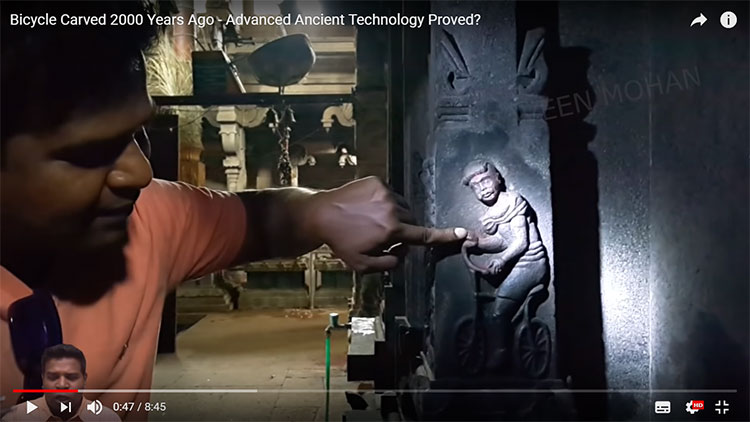Discover shocking images of modern bicycles in the 2,000-year-old temple
The image of a bike carved out on a wall in the temple of Panchavarnaswamy, built by ancient Indians during the Chola period.
On a trip to discover the ancient temple of Panchavarnaswamy in Tamil Nadu state, India, Praveen Mohan discovered an amazing carvings of a modern bicycle in an ancient 2,000-year-old temple .
Reversing the history of bicycles, the forerunner of a bicycle today is believed to be Baron Drais' walking machine that appeared in 1817 in Germany. But recently, searchers discovered the image of a woman riding a bicycle with a similar design to a modern bicycle in an ancient temple dating back to 2,000 years, 1,800 years earlier. The body of the bike was born.
This unexpected discovery opens up questions about the birth of a bicycle, is it that the ancient Indians were able to predict the future of thousands of years later, or were they the ones who gave it? image of a modern and useful human transportation?
Praveen Mohan, who discovered the carvings on the wall and posted on his personal youtube channel, recounted: "In a dark corner of the wall, we found an amazing image of a person sitting. on the bike ".

Humanoid sitting on a modern bike in an ancient temple 2,000 years.(cut from clip).
"The historians all told us about the first bike invented in the 1800s, that is, only 200 years ago. But this ancient wall carved has 2,000 years ago." , Mohan wondered.
From the image of the bicycle Mohan recorded in the temple, the similarity with modern bicycles can be seen.
To answer this mystery, Dr. - historian R Kalaikovan gave a rather reasonable explanation.
He said that in 1920, the Panchavarnaswamy temple was renovated , it was also the time that the bicycle became popular and the design was compact and less cumbersome than the bicycle of the earlier periods. 'Perhaps the sculptor of the temple saw someone walking on the bike, was impressed and recorded the mark by floating on the wall', Mr. R Kalaikovan explained.
This seems to be a convincing answer, but there is still no definitive evidence and a truly accurate explanation of the modern bicycle image in Panchavarnaswamy temple.
- Mystery of temples 'timeless' in India: There is a value of up to 100 billion USD!
- 'Unbelievable' the bike without chains - the breakthrough of world science
- 10 models of bike with the best design
- Found a 5,000 year old stone temple
- Discovered 3,000-year-old megalithic temple in Peru
- Discovered a 6000-year-old ancient temple in Ukraine
- Mexico unearthed the temple of wind gods under the supermarket nail
- The fully wooden bike can function normally
- Video: Discover the oldest modern fossil outside Africa
- Discovered a thousand-year-old Cham temple complex
- Discovering a huge 3,000-year-old Sun temple in China
- Mysterious temple in India is carved from a single stone block
 Discovered an ancient centipede fossil 99 million years old
Discovered an ancient centipede fossil 99 million years old Discovered bat-like dinosaurs in China
Discovered bat-like dinosaurs in China Discovered a 200-year-old bronze cannon of the coast
Discovered a 200-year-old bronze cannon of the coast Discover 305 million-year-old spider fossils
Discover 305 million-year-old spider fossils Why does a strange rain always fall on an 1800-year-old temple every June?
Why does a strange rain always fall on an 1800-year-old temple every June?  Ruins of an ancient temple dating back to the Ptolemaic period discovered in Egypt
Ruins of an ancient temple dating back to the Ptolemaic period discovered in Egypt  Gravity Defying Pillar in Indian Temple
Gravity Defying Pillar in Indian Temple  The Mystery of the Temple of Baalbek, Where Modern Technology Cannot Replicate the Construction Process!
The Mystery of the Temple of Baalbek, Where Modern Technology Cannot Replicate the Construction Process!  Revealing the mystery of a 2,700-year-old bronze shield and helmet
Revealing the mystery of a 2,700-year-old bronze shield and helmet  Legend of the first woman to be an Egyptian pharaoh
Legend of the first woman to be an Egyptian pharaoh 